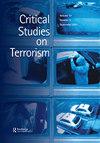Blackness after 9/11: topographies of race and counter-terror at the 9/11 memorial museum
IF 2.5
Q2 POLITICAL SCIENCE
引用次数: 0
Abstract
ABSTRACT More than a decade after the murder of Trayvon Martin and the creation of the Black Lives Matter protest movement, extrajudicial killings have become all too commonplace in the post-9/11 landscape, mirroring two decades of racialised surveillance against Arab and Muslim populations in the name of counter-terrorism. This paper maps Blackness’ proximity to the U.S. nation-state amidst the emergence of 9/11 memory and the post-9/11 counter-terrorism imaginary. Paramount to the longest war in US history (2001–2021), for example, Black patriotism is a powerful product and purveyor of the military industrial complex’s Global War on Terror. Yet while Black heroism and sacrifice are deeply encoded within the post-9/11 imaginary at the National September 11 Memorial & Museum at the World Trade Center, the Global War on Terrorism has ushered in the re-racialisation of both Brown and Black communities, as well as the fantasy of a “post-racial” nation now firmly in ruin in the age of Trumpism and the alt-right. Analysing key artefacts and narrative scripts within the 9/11 Memorial & Museum, I argue that 9/11 memory and the Global War on Terrorism work in tandem to reproduce new/old geographies of “terror” and “threat”, investigating how Blackness has always been central to the racialised logics of counter-terrorism and state surveillance.9/11后的黑暗:9/11纪念馆的种族和反恐地形
在特雷沃恩·马丁(Trayvon Martin)被谋杀和“黑人的命也是命”(Black Lives Matter)抗议运动发起十多年后,法外处决在9/11事件后的情况下变得太过普遍,反映了20年来以反恐名义对阿拉伯和穆斯林人口进行种族化监控的情况。本文在9/11记忆和后9/11反恐想象的出现中描绘了黑人与美国民族国家的接近。例如,对于美国历史上最长的战争(2001-2021)来说,黑人爱国主义是军事工业综合体全球反恐战争的强大产品和提供者。然而,尽管黑人的英雄主义和牺牲精神在世界贸易中心的9/11国家纪念博物馆(National Memorial & Museum)中被深深植入了后9/11时代的想象中,但全球反恐战争却带来了布朗和黑人社区的重新种族化,以及在特朗普主义和另类右翼时代,一个“后种族”国家已经彻底毁灭的幻想。通过分析9/11纪念馆和博物馆内的关键文物和叙事脚本,我认为9/11记忆和全球反恐战争协同工作,重现了“恐怖”和“威胁”的新/旧地理,调查了黑人如何始终是反恐和国家监视的种族化逻辑的核心。
本文章由计算机程序翻译,如有差异,请以英文原文为准。
求助全文
约1分钟内获得全文
求助全文

 求助内容:
求助内容: 应助结果提醒方式:
应助结果提醒方式:


